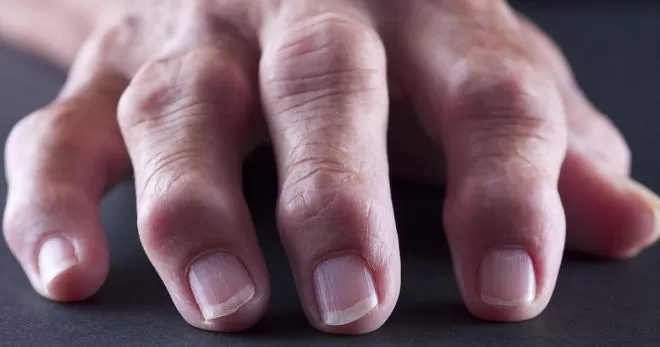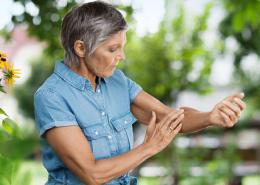A Personal Take on Living with RA

A young woman with a busy life, Jamie Navarette, has an advanced college degree and a full-time job and spends a lot of her free time serving as a health advocate and educator. Jamie also has rheumatoid arthritis (RA), a painful and disabling disease that affects the joints with pain, swelling and stiffness.
A Body’s Betrayal
Days before her senior prom, when she was just 18, Jamie experienced flu-like symptoms and achiness. She also noticed swelling and tenderness in her fingers on one hand. Assuming it was nothing serious, Jamie ignored her symptoms.
It was at the start of her first semester in college that Jamie again felt pain, swelling and tenderness, but this time it was in her other hand. Her symptoms quickly progressed and worsened in that she could barely lift her arms over her head to get dressed, or press the keys on her computer keyboard. The pain became severe and intense—Jamie found herself completely fatigued and bed-ridden.
One night during that same semester, Jamie attempted to crawl her way to the dorm bathroom, but lost control of her bladder before she could get there. She ended up in the emergency department of a local hospital.
Otherwise young and healthy, she found the whole thing difficult to understand. She thought, “What was happening? Why was my body betraying me like this?”
A Classic Case
Rheumatoid arthritis is an autoimmune disease in which the body’s immune system attacks itself, creating inflammation and damage to the joints and may also affect body organs, such as eyes, lungs, and heart. RA is most common in middle-aged women and older men, but can also occur in young people. Having a family member with RA may increase the odds of having the disease, but the majority of people, like Jamie, have no such family history.
“My symptoms were pretty classic, so the rheumatologist said he thought there was a 90% chance that what I had was RA,” says Jamie. Her pain and swelling occurred in several small joints such as her fingers, wrists, and ankles. In most RA cases, symptoms occur in the same joints on both sides of the body. After reviewing Jamie’s medical history, physical findings, and test results, the doctor confirmed that she had RA.
Living with RA
Jamie went through a period of adjustment following her diagnosis. “When I first found out I had RA, I was angry, discouraged, and overwhelmed,” she says. “I was going to have it for the rest of my life…and that was hard.” She soon took steps to manage her disease.
She quickly learned the importance of working closely with her healthcare team—RA treatments do not work the same way for all people with the disease. “Being able to have a two-way conversation with a healthcare provider around treatment and managing pain is important, because it’s your body, and there are options. No one else is going to care about it the way that you do. You need to be an active participant in your treatment from the first day forward.”
Jamie also does everything she can to live a full and healthy life, and advises the following tips:
- Eat a healthy diet with fruits, vegetables, and lean meats.
- Stay active, with low-impact activity—such as stretching, walking or swimming—to keep your joints in motion.
- Rest when symptoms are severe.
- Get a good night’s sleep whenever possible.
- Build a support network because talking about chronic pain and what you’re feeling is important.
- Enjoy life and keep things light by hanging out with people who also love to laugh.
Jamie’s day-to-day life is certainly not without its challenges. There are days when opening a bottle of water or dressing in the morning seems impossible. But, she learned to make changes here and there. For example, she no longer owns clothing with buttons.
She doesn’t hide her struggles from everyone as she did in the beginning, and has learned to talk about it, and ask for help. “It’s important to seek support and talk about the pain and the struggles. It’s important to make your supervisor, your coworkers, and your family aware of your situation. I think pain is worsened by feelings of isolation and loneliness. And no one can do it all alone.”
“The day I realized that I didn’t do anything wrong was the day I took my power back,” she says. “I finally understood that RA just happens to some people.”
Hear more from Jamie herself in these videos:
- My RA Symptoms & Diagnosis: Jamie Navarette
- Working with your RA Healthcare Team: Jamie Navarette
- Managing Rheumatoid Arthritis Pain: Jamie Navarette
- Living with Rheumatoid Arthritis: Jamie Navarette
References
- 1. AF Combating. Arthritis Foundation – Combating High Disease Activity in Early RA. Accessed December 14, 2016.
- 2. AF Self Care. Arthritis Foundation – Rheumatoid Arthritis Self-Care. Accessed December 14, 2016.
- 3. AF Sleep. Arthritis Foundation – Rheumatoid Arthritis and Sleep. Accessed December 14, 2016.
- 4. AF Symptoms. Arthritis Foundation – Rheumatoid Arthritis Symptoms. Accessed December 14, 2016.
- 5. AF What is. Arthritis Foundation – What is Rheumatoid Arthritis? Accessed December 14, 2016.





